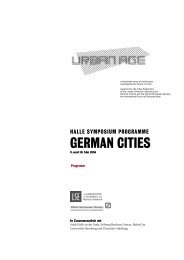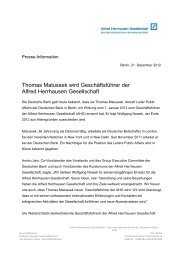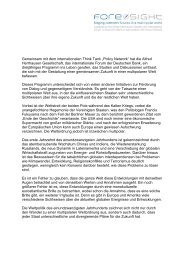Charting new directions: - Alfred Herrhausen Gesellschaft
Charting new directions: - Alfred Herrhausen Gesellschaft
Charting new directions: - Alfred Herrhausen Gesellschaft
You also want an ePaper? Increase the reach of your titles
YUMPU automatically turns print PDFs into web optimized ePapers that Google loves.
<strong>Charting</strong> <strong>new</strong> <strong>directions</strong>: Brazil’s role in a multi-polar world 49For every R$100 spent by thegovernment on social spending,R$137 is generated in GDPmultiplier of spending on public debt interest (0.71%)and almost identical to that of commodity exports(1.40%), but falls below that of investment in civilconstruction (1.54%).Exhibit 1 Economic Cycle of Social Public SpendingMultiplier1% GDP increase inSocial Policy SpendingNationalAccountsmatrix=1.37%GDP Growth=1.85%Growth inhouseholdincomeNational Taxation System56% of SPS returns to the state in taxes and contributionsThe data also shows that the state receives 56% ofthe amount that it originally spent in the form of taxrevenues. In other words, out of every R$100 initiallyspent, R$56 is returned in the form of national taxrevenues.In terms of household income, the simulationsshow that an increase of one percent of GDP in theaforementioned social programmes and policiesraises household income by 1.85% on average,where household income represented around 81%of GDP in 2006. The multiplier of social spendingon household income is much greater than themultiplier of investment in civil construction (1.14)and commodity exports (1.04).In other words, these results show that the notionthat social spending is economically futile is untrue.Rather, it is a very important element in the dynamicsof the national economy, mainly of that targeted tothe local market.In the case of monetary transfers, the biggestmultiplier of GDP and of household income belongs toBolsa Familia. For every R$1.00 spent on the program,GDP will rise by R$1.44 and household income by2.25% in the overall circuit of income multiplicationin the economy. By way of comparison, spendingof R$1.00 in interest on public debt will generateonly R$0.71 of GDP and a 1.34% rise in householdincome. In other words, at least in terms of GDPgeneration, the cost of interest payments outweighsthe benefits, whereas Bolsa Familia generates moreeconomic benefits than it costs.Even the social security system’s transfers toretirement, pension and assistance payments havea substantial multiplier effect (1.23). The explanationlies in the fact that, due to Brazil’s still abysmalincome inequality, an almost neutral transfer leadsto a significant improvement in inequality levels andthus in the consumption propensity and profile of thepopulation as a whole.The income transfers that most benefit the pooreststrands of society provide a further boost to GDPand household income because poorer people tendto consume virtually their entire income (they cannotsave) and spend it on national products, with fewerimports in their consumption basket. Therefore, inthis case the degree of leakage is much lower.Laying the foundationsThe Brazilian population has achieved major socialprogress in recent years. These achievementsdemanded a greater effort in terms of funds forfinancing programmes and actions. This enabled thecreation of a number of technical and administrativemechanisms which involved the hiring and training ofThe Construction of a Strategic Social Policy | Jorge Abrahão de Castro








